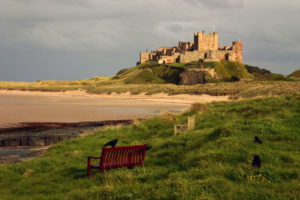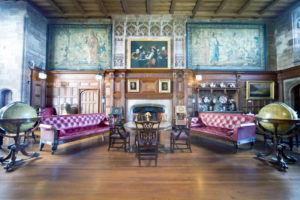
An intact and inhabited Norman castle. The imposing location of Bamburgh, on top of a high basalt crag overlooking expansive sands and the wild North Sea, has made it one of the star attractions of many a book on castles. In medieval texts it was identified as Lancelot’s Joyeus Garde Castle in the Arthurian tradition. The ancient capital of the powerful kingdom of Northumbria, there has been some kind of defensive structure at Bamburgh since at least the 6th century. It has been suggested that occupation of this naturally defensive site on top of an outcrop of the Whin Sill dates back thousands of years, and that it was used as the location for a beacon in Roman times.

The first written reference to the castle dates from AD 547 when it was captured by the Anglo-Saxon ruler Ida of Bernicia. At this point, the fortifications were made of wood. The early name of the site, Din Guyardi, predates Ida. Bamburgh was subsequently the seat of the kings of Northumbria, possibly taking its later name of Bebbanburgh from Bebbe, the second wife of Ida’s grandson King Aethelfrith of Bernicia (593-617). King Oswald of Northumbria, son of Aethelfrith and his first wife Acha, was the ruler who invited Saint Aidan to preach nearby and so brought Christianity to the kingdom. Oswald granted land to Aidan to create the religious foundation at nearby Lindisfarne. After his death in battle, Oswald became patron saint of Northumberland, with a cult that extended far beyond the region.

Above: Bamburgh Castle
Christianity was well-established in north east England by the 8th century, but the kingship was increasingly weak. On June 8th 793, a fateful day for Northumbria, Viking raiders attacked the monastery of Lindisfarne. Viking raids on wealthy targets continued, the balance of power shifted, and kingdoms elsewhere on the island became dominant.

In 1095, the massive Norman keep at Bamburgh was constructed and the next stage of the history of Bamburgh began. Bamburgh was temporary home – and sometimes prison – to members of the Scottish aristocracy. During the Wars of the Roses, Bamburgh was a Lancastrian stronghold that came under fierce attack. By the early 1600s, Bamburgh was ruinous and in private hands, those of the local Forster family. It later became a hospital and a school, before being bought by the wealthy local industrialist, Lord Armstrong, who began the work of restoration but died before it was completed.
Owned today by the Armstrong family, Bamburgh Castle is open to the public. Entrance charges apply.

Above: Interior of Bamburgh Castle. Attribution: Steve Collis. Licensed under the Creative Commons Attribution 2.0 Generic license.